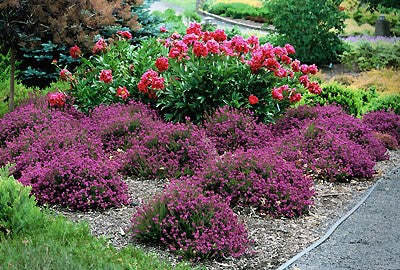by Ken Lain, the mountain gardener

This impressive bloomer is covered with flowers late Winter through Spring. Animal resistive with fragrance all pollinators adore. A knee-high evergreen is super easy to care for in the ground or containers.
The evergreen foliage produces so many flowers the fern-like leaves are lost. This little shrub has flowers at a time of year when few other plants bloom. Winter heath is valued by homeowners seeking year-round interest in the yard.
Botanical Name Erica x darleyensis
Common Name Heather
Size 1′ ft. tall x 3′ ft. wide
Bloom Time Winter to early Spring.
Plant Type Evergreen Perennial
Flower Color Pink
Foliage Green
Growth Habit Mounding
Growth Rate Moderate
Landscape Use Border, Container, Erosion Control, Rock Garden, Ground Cover
Sun 6+ Full sun, Partial sun
Special Feature Easy Care, Year-round Interest, Bird Friendly
Water Need Moderate
USDA Zone 6 – 8
Key Feature Winter Flowering
Plant Specs
Its leaves take on tiny needles. The pink flowers are bell-shaped and almost totally cover the shrub when the plants are in bloom. The common name “winter heath” alludes to the blossoming period.
1.Dig hole 2-3 times the width of the container but the same depth.
2. Score the root ball sides and bottom with a utility knife or pruners and plant in the planting hole.
3. Blend Watters Premium Mulch into the native soil at 1 part mulch with two parts soil dug from the hole and pack firmly around the roots.
4. Sprinkle 7-4-4 All Purpose Plant Food around the planting area.
5. Prevent ‘Transplant Shock’ by adding Watters “Root & Grow” to your water at 2-week cycles for the first 2 months.
6. Use the remaining Watters Mulch inside the tree well as a top dressing. This will keep weeds down, insulate roots from heat and cold, and keep the roots moist.

Light
To keep Heath happy, give it 6+ hours of full sunlight each day. When growing it indoors, place it in a south-facing window for bright light.
Soil
Grow Heath in loamy, well-draining soil. This plant is native to the rocky alpine hillsides and doesn’t do well if its roots stay soggy. Test the planting hole by filling it with water in the morning. If water is still pooling in the dug hole at the end of the day, you have drainage issues that will need more work.
Water
Water newly planted Heath regularly with a garden hose for at least one month (2 months in Summer). Automatic irrigation systems may not be sufficient initially. Water frequency will vary according to the season, exposure, and plant size.
April – Oct Heath should be irrigated 2 x weekly.
Nov – Mar Heath should be irrigated 2 x monthly.
Fertilizer
Feed 4x Times per Year with either 7-4-4 All Purpose Plant Food, Soil Sulfur, or Humic. Here’s the recommendation by season:
Spring = 7-4-4 All Purpose Food + Soil Sulfur
Summer = 7-4-4 All Purpose Food + Humic
September = 7-4-4 All Purpose Food
December = 7-4-4 All Purpose Food
Uses in Landscaping
As small shrubs with dense foliage, Heath can be massed together to form a ground cover that suppresses weeds. Heaths can be treated as spreading groundcover or as small mounding shrubs. They are best used in wild or rock gardens, where they can develop naturally. Particularly attractive when allowed to cascade off retaining walls and edges of raised planters.
Better Together: Companion Plants for March
Prescott Pansy
Giants 3″ flowers thrive in extreme March gardens. Large, velvety blooms dazzle with radiant colors of blue, violet, yellow, and variations of stripes that look like smiling faces and love being planted in March.
Fanciful Forsythia
This gorgeous shrub explodes with masses of solar yellow flowers followed by shiny green leaves. Every home should have one for sheer beauty, fall color, and gentle natural care.
Oklahoma Redbud
At just 16′ feet tall, this local native is super easy to grow. Vibrant, red flowers cloak the branches of early Spring. Luscious heart-shaped leaves emerge with a soft pink tinge that matures to a vibrant green.
Rosemary Creeper
A local favorite for rock gardens, groundcover, or spilling over retaining walls, not all local rosemary is created equal. This one lives where others die. Knowing you can also use it in the kitchen is sheer bliss.

